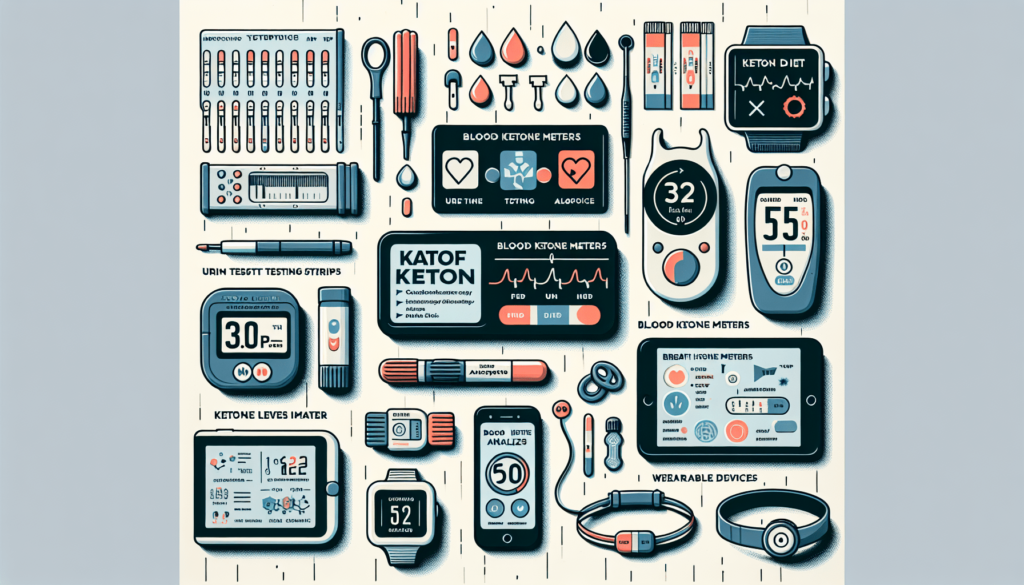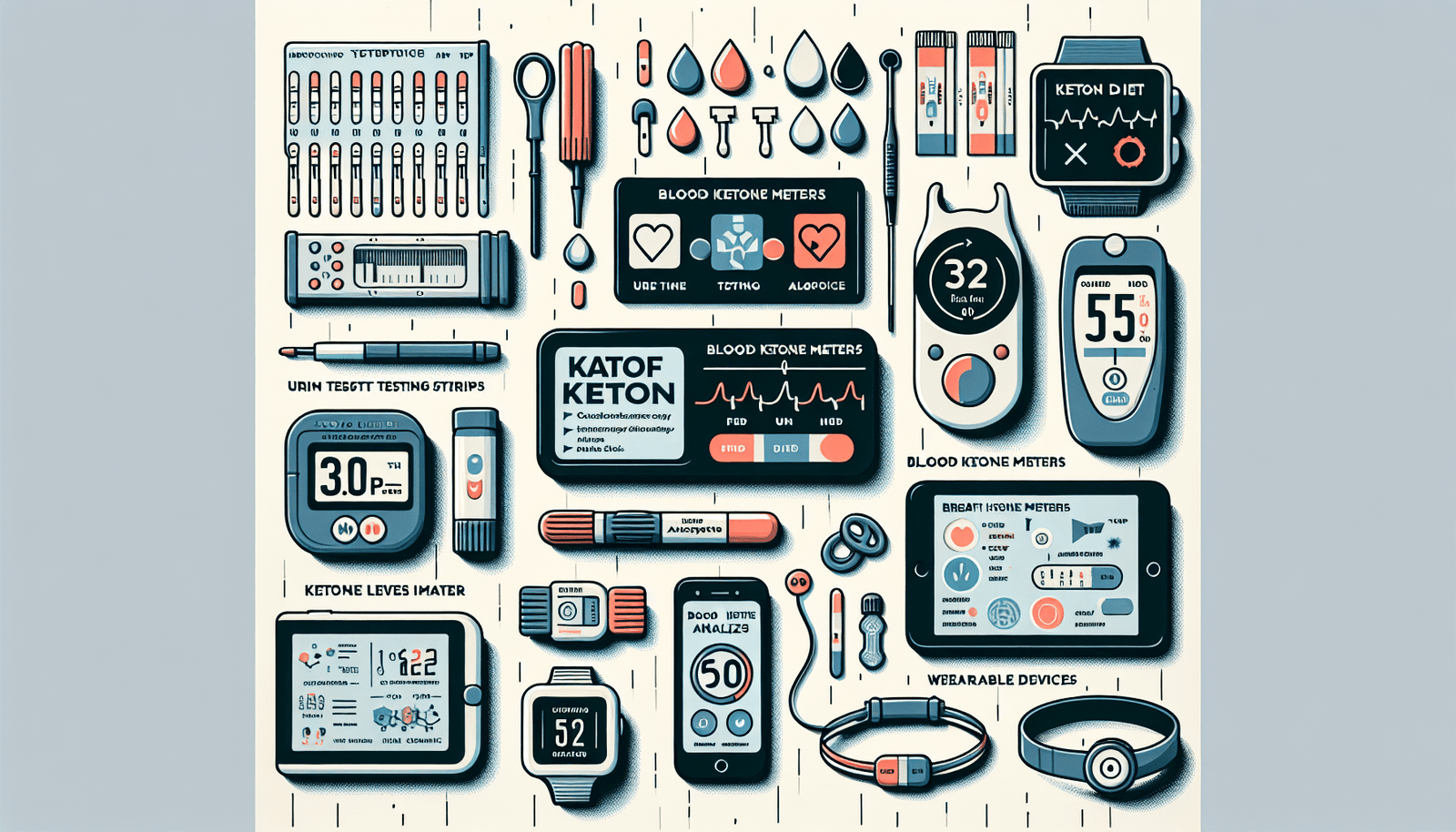Are you curious about how to accurately measure ketosis while following a ketogenic diet? Look no further! In this article, we will explore the most effective methods for tracking your ketone levels, helping you stay on track and optimize your results. Whether you’re a seasoned keto dieter or just embarking on this low-carb journey, understanding how to measure ketosis will provide valuable insights into your metabolic state and help you make informed decisions about your diet and lifestyle. So let’s dive in and discover the best ways to assess and monitor your ketone levels on a keto diet!

Blood testing
Ketone blood meter
One of the most accurate and reliable methods of measuring ketosis on a keto diet is through blood testing. This involves using a ketone blood meter to measure the level of ketones in your blood. The process is simple and requires a small blood sample, usually obtained by pricking your finger with a lancet. This blood sample is then placed on a ketone test strip, which is inserted into the ketone blood meter. The meter will analyze the sample and provide you with a reading of your blood ketone levels.
Blood ketone testing
Blood ketone testing is a direct and precise way to determine your ketone levels. It measures the concentration of the ketone body beta-hydroxybutyrate (BHB) in your blood. BHB is the main ketone produced during ketosis and is an excellent indicator of how deeply you are in ketosis.
Pros and cons
There are several advantages to using a ketone blood meter for measuring ketosis. One of the key benefits is its accuracy compared to other methods like urine or breath testing. Blood testing provides a real-time measurement of your ketone levels, allowing you to adjust your diet and exercise accordingly. It also helps you track the progress of your ketogenic diet and ensure that you are staying in ketosis.
However, blood testing does come with a few drawbacks. First, it requires a blood sample, which can be uncomfortable for some individuals. Additionally, blood ketone test strips can be costly compared to other testing methods. Lastly, blood testing may not be suitable for everyone, especially those with medical conditions that affect blood clotting or individuals who have a fear of needles.
Urine testing
Ketone urine strips
Another method to measure ketosis is through the use of ketone urine strips. These strips are dipped into a urine sample, and they change color based on the concentration of ketones in the urine. The darker the color, the higher the ketone levels.
Urine testing process
When using ketone urine strips, it is important to follow the instructions provided. You will typically need to collect a urine sample in a clean container and then dip the strip into the urine for a few seconds. After removing the strip, you will compare the color change against the chart provided with the strips to determine your ketone levels.
Accuracy and limitations
While urine testing is a simple and cost-effective method, it does have limitations. Ketone urine strips primarily measure the ketone acetoacetate (AcAc), which is not as accurate as measuring beta-hydroxybutyrate (BHB) levels in the blood. Additionally, the color change on the strips can be affected by factors such as hydration levels, making it less accurate for some individuals.
Breath testing
Ketone breath analyzer
Breath testing is another non-invasive method of measuring ketosis. It involves using a ketone breath analyzer to detect the presence of ketones in your breath. These analyzers work by measuring the amount of acetone in your breath, which is a byproduct of ketone metabolism.
Breath testing process
To measure ketones using a breath analyzer, you simply breathe into the device and wait for the reading. The analyzer will provide you with a numerical value indicating the concentration of acetone in your breath.
Pros and cons
Breath testing has its advantages, including its non-invasive nature and convenience. It does not require blood or urine samples, making it a more comfortable option for some individuals. Breath analyzers are also reusable and do not require ongoing purchases like test strips.
However, breath testing may not be as accurate as blood testing when it comes to determining ketone levels. Acetone levels in the breath can be influenced by other factors such as alcohol consumption or certain medications, which could affect the accuracy of the readings.
Symptom observation
Increased energy
One of the benefits often experienced on a keto diet is increased energy levels. As your body adapts to using ketones as its primary fuel source instead of glucose, you may find that you have more sustained energy throughout the day. This increase in energy can be a positive indicator that you are in ketosis.
Decreased appetite
Another symptom commonly associated with being in ketosis is a suppressed appetite. Ketones have been shown to have appetite-suppressing effects, which can lead to reduced hunger and a decrease in overall calorie consumption. If you find yourself feeling less hungry or experiencing a reduced desire for food, it may be an indication that you are in ketosis.
Mental clarity
Many people report improved mental clarity and focus when following a ketogenic diet. This is often attributed to the ketones’ ability to provide a stable source of energy to the brain. If you notice improved cognitive function, better concentration, or enhanced mental clarity, it could be a sign that you are in ketosis.
Weight loss
Weight loss is a common goal for individuals following a keto diet, and it can serve as an indication of being in ketosis. When your body is in ketosis, it is more efficient at utilizing stored fat for energy, leading to weight loss. If you are consistently shedding pounds and inches, it is likely a sign that you are in a state of ketosis.

Monitoring macros
Tracking carbohydrates
One essential aspect of maintaining a ketogenic state is tracking your carbohydrate intake. To achieve and sustain ketosis, it is crucial to limit your carbohydrate consumption to a specific threshold, typically around 20-50 grams per day, depending on individual needs. Keeping track of your carbohydrate consumption helps ensure that you are within the appropriate range and staying in ketosis.
Tracking protein
While protein is an essential macronutrient, excessive intake can potentially kick you out of ketosis. Tracking your protein intake allows you to monitor whether you are consuming an appropriate amount for your individual needs. It is recommended to consume moderate amounts of protein as excessive protein intake can be converted to glucose through a process called gluconeogenesis.
Tracking fat
To achieve and maintain ketosis, it is crucial to consume an adequate amount of healthy fats. Tracking your fat intake helps ensure that you are meeting your daily fat requirements while keeping your overall macronutrient ratios in balance. Opting for healthy fats such as avocados, nuts, and olive oil can contribute to your overall well-being on a ketogenic diet.
Maintaining the right ratios
When following a ketogenic diet, it is essential to maintain specific macronutrient ratios to achieve and sustain ketosis. The general recommendation is to consume approximately 70-75% of your daily calories from fat, 20-25% from protein, and 5-10% from carbohydrates. By tracking your macro ratios, you can ensure that you are staying within the appropriate ranges for optimal ketosis.
Measuring blood glucose
Importance of blood glucose
While ketone levels are crucial for determining ketosis, monitoring blood glucose levels is equally important. On a keto diet, maintaining stable blood glucose levels is key to preventing insulin spikes and maintaining a state of ketosis. Regularly monitoring your blood glucose allows you to identify any potential issues and make adjustments to your diet and lifestyle as needed.
Impact on ketosis
Blood glucose levels and ketosis are closely interconnected. Consuming too many carbohydrates or experiencing blood sugar fluctuations can inhibit ketone production and kick you out of ketosis. By measuring your blood glucose levels, you can ensure that they are within the desired range and support your ketogenic state.
Using a glucometer
To measure blood glucose levels, you can use a glucometer. This handheld device requires a small blood sample, usually obtained by pricking your finger. The blood sample is then placed on a test strip, which is inserted into the glucometer. Within seconds, the device displays your current blood glucose level, allowing you to monitor your glucose levels and make any necessary adjustments to your diet or lifestyle.
Monitoring ketone production
Ketone production indicators
Monitoring ketone production is essential for maintaining and optimizing your state of ketosis. Various indicators can provide insight into your ketone production levels. These include your blood ketone levels, as measured by a ketone blood meter, as well as the presence of acetone in your breath or urine.
Measuring acetone levels
Acetone, a byproduct of ketone metabolism, can be measured to assess ketone production. Breath analyzers, specifically designed to measure acetone levels, provide a non-invasive method of testing. Ketone urine strips can also indicate the presence of acetone in your urine, although they may not be as accurate as blood or breath testing.
Ketostix
Ketostix are small test strips that can be used to measure the presence of ketones in your urine. These strips change color based on the concentration of ketones, particularly acetoacetate, in your urine. While they are a convenient and affordable option, they may not provide the same level of accuracy as blood or breath testing methods.
Physical performance measurement
Endurance
One way to assess the impact of a ketogenic diet on your physical performance is by measuring your endurance. Ketosis has the potential to enhance endurance by providing a steady supply of energy from fats. If you notice improved stamina, increased ability to maintain high-intensity workouts, or prolonged endurance during physical activities, it may indicate that you are adapted to using ketones for fuel.
Strength
Monitoring your strength levels is another way to assess the impact of ketosis on your physical performance. While there may be an initial period of adaptation, where strength levels may temporarily decrease, many individuals report maintaining or even improving their strength once fully adapted to a ketogenic diet. By tracking your strength progress, you can gauge how well your body is responding to ketosis.
Sustainable energy levels
One of the significant benefits of being in ketosis is the sustained energy levels it provides. By utilizing fat as the primary fuel source, your body can access a more stable and longer-lasting energy supply. If you find that you have sustained energy levels throughout the day, without the crashes often associated with carbohydrate-heavy diets, it can indicate that you are effectively in ketosis.
Body measurements
Weight
Monitoring your weight is a common practice when following any dietary plan, including a ketogenic diet. Weight loss is often a desired outcome, and tracking your weight allows you to assess your progress and make any necessary adjustments. However, it is essential to remember that weight loss is not the sole indicator of ketosis, as factors like water retention and muscle gain can influence overall weight.
Body fat percentage
Measuring your body fat percentage provides a more accurate assessment of your body composition compared to weight alone. While the scale may not show a significant change, a reduction in body fat percentage suggests that you are losing fat while preserving or gaining lean muscle mass. Body fat calipers, body composition scales, or professional body fat measurements can be used to track changes in body fat percentage.
Waist circumference
Another meaningful measurement to consider is your waist circumference. Excess belly fat, often stored as visceral fat, is associated with various health risks. Tracking your waist circumference can help determine if you are losing belly fat, which is a positive outcome of being in ketosis. By regularly measuring your waist, you can track the reduction in inches and monitor your progress.
Self-reflective assessment
How do you feel?
Ultimately, one of the most valuable ways to assess if you are in ketosis is by reflecting on how you feel. Pay attention to your overall well-being, energy levels, mental clarity, and any other subjective markers of well-being. If you feel energetic, focused, and experience other positive effects associated with being in ketosis, it is a good indication that you are on the right track.
Are you meeting your goals?
Regularly evaluate if you are meeting your goals based on your desired outcomes on the ketogenic diet. Whether your goal is weight loss, improved athletic performance, or better overall health, assess if you are making progress towards those goals. If you are consistently achieving the desired outcomes, it suggests that you are successfully in ketosis and your efforts are paying off.
Are you in ketosis?
By considering the various measurement methods discussed, reflecting on your symptoms, and evaluating your progress towards your goals, you can determine if you are in ketosis. Utilize a combination of objective measurements and subjective assessments to gain a comprehensive understanding of your ketosis status. Remember that everyone’s journey is unique, and it may take time to find the most accurate and reliable methods for measuring ketosis in your own body.

